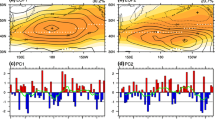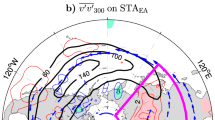Abstract
The first EOF mode (EOF1) of summer storm track activity over the North Atlantic is characterized by a dipole structure, with negative storm track anomalies over the south coast of Greenland extending northeast across Iceland to the Norwegian Sea and positive anomalies over coastal western Europe. This study shows that a significant interdecadal change in the North Atlantic storm track during boreal summer occurred around the mid-2000s. After the mid-2000s, the EOF1 occurs more frequently at its positive phase, which is associated with an interdecadal increase in the geopotential height anomalies around Greenland. On the intra-seasonal timescale, the anticyclonic anomalies around Greenland are crucial for the occurrence of positive EOF1 events via triggering eastward propagating Rossby waves. Therefore, the interdecadal increase in the geopotential height anomalies around Greenland tends to facilitate the occurrence of the positive EOF1 event and is therefore a key driver of the interdecadal change in the summer storm track activity over the North Atlantic. Further analysis indicates that the development of anticyclonic anomalies around Greenland is maintained by the self-interaction among the low- and high-frequency transients themselves. Moreover, the anomalous synoptic eddy activities associated with the change in storm tracks can in turn amplify and maintain the Rossby waves triggered by the anticyclonic anomalies around Greenland in the synoptic-scale eddy feedback process.














Similar content being viewed by others
References
Benjamini Y, Hochberg Y (1995) Controlling the false discovery rate: a practical and powerful approach to multiple testing. J R Stat Soc 57:289–300
Blackmon ML (1976) A climatological spectral study of the 500 mb geopotential height of the Northern Hemisphere. J Atmos Sci 33:1607–1623
Branstator G (1995) Organization of storm track anomalies by recurring low-frequency circulation anomalies. J Atmos Sci 52:207–226
Briffa KR, Schrier GVD, Jones PD (2009) Wet and dry summers in Europe since 1750: evidence of increasing drought. Int J Climatol 29:1894–1905
Brown SJ (2017) The drivers of variability in UK extreme rainfall. Int J Climatol 38:119–130
Cai M, Den Dool HMV (1994) Dynamical decomposition of low-frequency tendencies. J Atmos Sci 51:2086–2100
Chang EKM, Fu Y (2000) Interdecadal variations in Northern Hemisphere winter storm track intensity. J Clim 15:642–658
Chang EKM, Yu DB (1999) Characteristics of wave packets in the upper troposphere. Part I: Northern Hemisphere winter. J Atmos Sci 42:1708–1728
Chang EKM, Lee S, Swanson KL (2002) Storm track dynamics. J Clim 15:2163–2183
Chen S, Chen W, Yu B (2014) Asymmetric influence of boreal spring Arctic Oscillation on subsequent ENSO. J Geophys Res Atmos 119:11135–11150. https://doi.org/10.1002/2014JD021831
Dee DP et al (2011) The ERA-Interim reanalysis: configuration and performance of the data assimilation system. Q J R Meteorol Soc 137:553–597
Ding Q et al (2017) Influence of high-latitude atmospheric circulation changes on summertime Arctic sea ice. Nat Clim Change 7:289–295. https://doi.org/10.1038/nclimate3241
Dong B, Sutton RT, Woollings T, Hodges K (2013) Variability of the North Atlantic summer storm track: mechanisms and impacts on European climate. Environ Res Lett 8:4037
Feldstein SB (2002) Fundamental mechanisms of the growth and decay of the PNA teleconnection pattern. Q J R Meteorol Soc 128:775–796
Feldstein SB (2003) The dynamics of NAO teleconnection pattern growth and decay. Q J R Meteorol Soc 129:901–924. https://doi.org/10.1256/qj.02.76
Folland CK, Knight J, Linderholm HW, Fereday D, Ineson S, Hurrell JW (2009) The summer North Atlantic Oscillation: past, present, and future. J Clim 22:1082–1103. https://doi.org/10.1175/2008jcli2459.1
Francis JA, Vavrus SJ (2012) Evidence linking Arctic amplification to extreme weather in mid-latitudes. Geophys Res Lett 39:L06801. https://doi.org/10.1029/2012gl051000
Gong T, Feldstein S, Lee S (2017) The role of downward infrared radiation in the recent Arctic winter warming trend. J Clim 30:4937–4949
Gudmundsson L, Seneviratne SI (2015) European drought trends. Proc IAHS 369:75–79
Hanna E, Jones JM, Cappelen J, Mernild SH, Wood L, Steffen K, Huybrechts P (2013) The influence of North Atlantic atmospheric and oceanic forcing effects on 1900–2010 Greenland summer climate and ice melt/runoff. Int J Climatol 33:862–880. https://doi.org/10.1002/joc.3475
Hanna E et al (2014) Atmospheric and oceanic climate forcing of the exceptional Greenland ice sheet surface melt in summer 2012. Int J Climatol 34:1022–1037. https://doi.org/10.1002/joc.3743
Hanna E, Cropper TE, Hall RJ, Cappelen J (2016) Greenland Blocking Index 1851–2015: a regional climate change signal. Int J Climatol 36:4847–4861. https://doi.org/10.1002/joc.4673
Hanna E, Hall R, Overland JE (2017) Can Arctic warming influence UK extreme weather. Weather 72:346–352
Hawcroft MK, Shaffrey LC, Hodges KI, Dacre HF (2012) How much Northern Hemisphere precipitation is associated with extratropical cyclones? Geophys Res Lett 39:24809
Hendon HH, Hartmann DL (1985) Variability in a nonlinear model of the atmosphere with zonally symmetric forcing. J Atmos Sci 42:2783–2797
Hong X, Lu R, Li S (2017) Amplified summer warming in Europe-West Asia and Northeast Asia after the mid-1990s. Environ Res Lett 12:094007
Hoskins BJ (1983) The shape, propagation and mean-flow interaction of large-scale weather systems. J Atmos Sci 40:1595–1612
Hoskins BJ, Valdes PJ (1990) On the existence of storm-tracks. J Atmos Sci 47:1854–1864
Hoskins BJ, James IN, White GH (1983) The shape, propagation and mean-flow interaction of large-scale weather systems. J Atmos Sci 40:1595–1612
Inatsu M, Mukougawa H, Xie SP (2003) Atmospheric response to zonal variations in midlatitude SST: Transient and stationary eddies and their feedback. J Clim 16:3314–3329
Kalnay E et al (1996) The NCEP/NCAR 40-year reanalysis project. Bull Am Meteorol Soc 77:437–471. https://doi.org/10.1175/1520-0477
Kaspi Y, Schneider T (2013) The role of stationary eddies in shaping midlatitude storm tracks. J Atmos Sci 70:2596–2613. https://doi.org/10.1175/jas-d-12-082.1
Lee S (1995) Localized storm tracks in the absence of local instability. J Atmos Sci 52:977–989
Lee SS et al (2012) Interdecadal changes in the storm track activity over the North Pacific and North Atlantic. Clim Dyn 39:313–327
Lepage Y (1971) A combination of Wilcoxon’s and Ansari–Bradley’s statistics. Biometrika 58:213–217
Löptien U, Ruprecht E (2010) Effect of synoptic systems on the variability of the North Atlantic Oscillation. Mon Weather Rev 133:2894–2904
Luo D, Diao Y, Feldstein SB (2011) The variability of the Atlantic Storm Track and the North Atlantic Oscillation: A Link between intraseasonal and interannual variability. J Atmos Sci 68:577–601
Matsumura S, Zhang X, Yamazaki K (2014) Summer Arctic atmospheric circulation response to spring Eurasian snow cover and its possible linkage to accelerated sea ice decrease. J Clim 27:6551–6558. https://doi.org/10.1175/jcli-d-13-00549.1
North GR, Bell TL, Cahalan RF, Moeng FJ (1982a) The latitude dependence of the variance of zonally averaged quantities. Mon Weather Rev 110:1434–1450
North GR, Bell TL, Cahalan RF, Moeng FJ (1982b) Sampling errors in the estimation of Empirical Orthogonal Functions. Mon Weather Rev 110:699–706
Overland JE, Francis JA, Hanna E, Wang M (2012) The recent shift in early summer Arctic atmospheric circulation. Geophys Res Lett 39:19804
Park DSR, Lee S, Feldstein SB (2015) Attribution of the recent winter sea ice decline over the Atlantic Sector of the Arctic Ocean. J Clim 28:4027–4033
Peterson TC, Hoerling MP, Stott PA, Herring SC (2013) Explaining extreme events of 2012 from a climate perspective. Bull Am Meteorol Soc 94:S1–S74
Pfahl S, Wernli H (2012) Quantifying the relevance of cyclones for precipitation extremes. J Clim 25:6770–6780
Schonher T, Nicholson SE (1989) The relationship between rainfall and ENSO events. J Clim 2:1258–1269. https://doi.org/10.1175/1520-0442
Screen JA (2013) Influence of Arctic sea ice on European summer precipitation. Environ Res Lett 8:4015
Shi N, Wang Y, Wang X, Tian P (2019) Interdecadal variations in the frequency of persistent hot events in boreal summer over midlatitude Eurasia. J Clim 32:5161–5177
Sutton RT, Dong B (1990s) Atlantic Ocean influence on a shift in European climate in the 1990s. Nat Geosci 5:788–792
Takaya K, Nakamura H (2001) A Formulation of a phase-independent wave-activity flux for stationary and migratory quasigeostrophic eddies on a zonally varying basic flow. J Atmos Sci 58:608–627
Trenberth KE (1986) An assessment of the impact of transient eddies on the zonal flow during a blocking episode using localized Eliassen-Palm flux diagnostics. J Atmos Sci 43:2070–2087
Vicenteserrano SM et al (2014) Evidence of increasing drought severity caused by temperature rise in southern Europe. Environ Res Lett 9:044001
Wallace JM, Lim GH, Blackmon ML (1988) Relationship between cyclone tracks, anticyclone tracks and baroclinic waveguides. J Atmos Sci 45:439–462
Wang L, Xu P, Chen W, Liu Y (2017) Interdecadal variations of the Silk Road pattern. J Clim 30:9915–9932. https://doi.org/10.1175/jcli-d-17-0340.1
Wang S, Nath D, Chen W, Wang L (2019) Recent strengthening of Greenland blocking drives summertime surface warming over northern Canada and eastern Siberia. J Clim 32:3263–3278
Wilks DS (2016) “The stippling shows statistically significant grid points”: how research results are routinely overstated and overinterpreted, and what to do about it. Bull Am Meteorol Soc 97:2263–2273. https://doi.org/10.1175/bams-d-15-00267.1
Acknowledgements
We thank two anonymous reviewers for their constructive suggestions, which helped to improve the paper. This study was supported jointly by the National Natural Science Foundation of China (Grants 4191101005 and 41721004), the Chinese Academy of Sciences Key Research Program of Frontier Sciences (QYZDY-SSW-DQC024) and the Jiangsu Collaborative Innovation Center for Climate Change.
Author information
Authors and Affiliations
Corresponding author
Ethics declarations
Conflict of interest
The authors declare no potential conflict of interest.
Additional information
Publisher's Note
Springer Nature remains neutral with regard to jurisdictional claims in published maps and institutional affiliations.
Rights and permissions
About this article
Cite this article
Wang, S., Chen, W., Chen, S. et al. Interdecadal change in the North Atlantic storm track during boreal summer around the mid-2000s: role of the atmospheric internal processes. Clim Dyn 55, 1929–1944 (2020). https://doi.org/10.1007/s00382-020-05360-w
Received:
Accepted:
Published:
Issue Date:
DOI: https://doi.org/10.1007/s00382-020-05360-w




